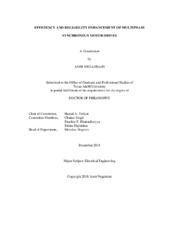| dc.description.abstract | Multiphase electric machines are attractive in comparison with three-phase ones due to advantages such as fault-tolerant nature, smaller rating per phase and lower torque ripple. More specifically, the machines with multiple three-phase windings are particularly convenient, because they are suitable for standard off-the-shelf three-phase dc/ac converter modules. For instance, they are becoming a serious option for applications such as electric vehicles and wind turbines. On the other hand, in these applications, operation at low power is often required for long time intervals; hence, improving the efficiency under such conditions is highly desired and could save a significant amount of energy in the long term. This dissertation proposes a method to enhance the efficiency of electric drives based on multiple three-phase windings at light load. The number of active legs is selected depending on the required torque at each instant. To ensure that the overall efficiency is effectively optimized, not only the converter losses, but also the stator copper losses, are taken into account. Experimental results verify the theoretical outcomes.
Surface-mounted permanent-magnet synchronous motors (SPMSMs) require a position measurement to ensure a high-performance control. To avoid the cost and maintenance associated to position sensors, sensorless methods are often preferred. The approaches based on high-frequency signal injection are currently a well-established solution to obtain an accurate position estimation in SPMSMs. These techniques can be roughly divided into two groups: those based on sinusoidal or on square-wave high-frequency signals. The main drawback of the former is the limitation on the response speed, due to the presence of several low-pass filters (LPFs). On the other hand, the latter methods are sensitive to deadtime effects, and high-frequency closed-loop current control is required to overcome it. This dissertation proposes to improve the sensorless strategies based on sinusoidal high-frequency injection by simplifying the scheme employed to extract the information about the position error. Namely, two LPFs and several multiplications are removed. Such simplification does not only reduce the computational complexity, but also permits to obtain a faster response to the changes in the angle/speed, and hence, a faster closed-loop control. Experimental results based on a SPMSM prove the enhanced functionality of the proposed method with respect to the previous ones based on high-frequency sinusoidal signal injection. | en |


